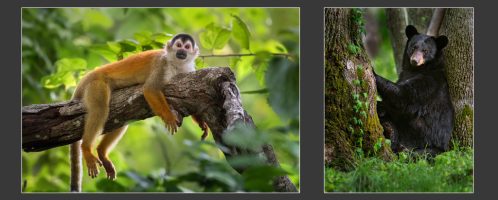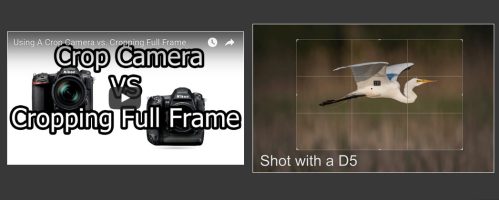Have you ever faced a low light or low contrast subject and discovered that, despite the viewfinder showing a confirmed AF lock, the camera actually missed critical focus?
If you answered yes, then you’re certainly not alone. You fell victim to the “false positive” AF lock – and it can be a heart breaker.
When I run across that scenario myself, I use the technique outlined in the video below to help overcome the problem. Plus, it works especially well for wildlife subjects with “challenging” facial structure too (deep-set eyes, slanted faces, – you know, the kinds of things where it’s tough to get right on the eye.
If you’re like me and are a stickler for a sharp eyeball, then you’re gonna love this video.
.
PS – If you enjoyed this post, I think you’ll REALLY like my e-books and video workshops! Thousands of pages and hours of videos filled with tips, tricks, and techniques – all my best content! Check ’em out – click here (hey, it’s free to look).




Interesting. When I graph a lens in focustune it shows the variance in autofocus lock from one (refocused) image to the next. Some lenses vary more than others but they all seem to do it. It’s brilliant to actually take advantage of this error. Thanks for the tip.
Great information Steve, one question when you focus do you take your finger off the off button when in focus. when following some thing flying keep your finger on the button
Steve, Most excellent instruction as usual. One thought. Focus performance is different when approaching from each of the two directions, ie, too far out to actual or too close to actual . Sometimes more accurate in one direction than other based on my and I imagine your Focal Software experience right? So wondering what you think of turning the ring one way, shoot burst then turn other way and shoot burst instead of same direction for all the times? Thanks for all your service to the photographic community. Have your Exposure and AF books and highly recommend them to all.… Read more »
Will this work with the Z cameras? When will you release your manual for the Zs?
This guy GOOD
totally support that comment
Nice video once again Steve. Question, are those leaf cutter Ants walking down the tree behind you?
Thanks – and yes they are.
I couldn’t take my eyes off them, a permanent conveyor belt down the tree.
Thanks, stay well Steve
Regards from England.
Gary
Another bunch of good tricks making me feel like going on the field to try it! Your videos are very constructive and indeed, your pictures veeeeeeeeeeeeeeeery sharp!
Thanks for the video Steve. Excellent as usual. One thing I have experienced with VR lenses is sharpness loss with the stabilizer active as if the floating lens element has not “settled down” … if that makes sense. I find I periodically lose critical sharpness when with VR enabled mainly on Nikon super telephotos even at decent shutter speeds. When this happens, I use your technique of making the subject totally out of focus and then shooting another burst once the lens locks on a second time. I’m not sure if you have experienced VR related sharpness issues. Also, I… Read more »
I see that as well from time to time, but usually shooting in short bursts solves the problem (and most of the time it’s not a problem). A good rule of thumb is to turn off VR when you start getting into faster shutter speeds where you really don’t need it.
Another Excellent tip/tips Steve, thank you
Have not tried the defocus option …………next challenge! 🙂
Regards,
Gary
Great tips, Steve. When shooting Barred Owls locally in a woodland and with already limited light around dusk, sharp eye focus (heck, any focus sometimes) can be a challenge. Exposure too with any semblance of shutter speed can be a challenge: for portrait shots (again, particularly of owls who will hold themselves incredibly still), with big glass, tripod mounted to the D850, I will utilise live view, AF-S and Fine Point, tapping the screen to put the single point on the eye. I use a Vello remote shutter release as shutter speeds for this technique are frequently at 1/5 sec… Read more »
My Dear Steve Perry – Watched the very nice video presentation and I am learning a lot. I am doing Wildlife Photography and your e-books and all other videos on Nikon Wildlife Photography very valuable Resources to Me. At the moment in my Research Library I have a collection of your e-books and a collection of videos too. I greatly appreciate your extra-ordinary works and the service you are doing for the sacred subject – WILDLIFE PHOTOGRAPHY. Once again Thank you very much for sharing and all Good Wishes to do more fruitful works for the betterment of Nature and… Read more »
Not surprising that eyes are a problem as the autofocus works by detecting areas of contrast and usually the areas around the eye provide more contrast for the sensors than the eye itself. With a moving subject I need to use autofocus but when the subject and I am stationary then I use manual focus most of the time as it provides me with the most control.
With some lenses, like my 80-400mm VR, the VR seems to cause a last second shift in the autofocus point and I try to avoid using VR with this lens.
Great tip. Often I’ve had to sharpen an eye or two. I’ll give it a try next time in such a situation. Great e-books, right to the point. Love your dialog.
Thanks so much. Great Information
Great video on a not uncommon problem sometimes faced by wildlife shooters. In your experience is Nikon AF when locked always or usually more accurate than old-school manual focus in low light/contrast scenarios? I guess my question is instead of slightly defocusing and then pushing AF-on more accurate than simply refocusing using only manual focus? Some cameras (Fuji mirrorless comes to mind) have a manual focus auto assist magnification feature and also focus peaking that can really help the speed and accuracy of critical manual focusing. Nikon I believe only has the focus assist light which isn’t of much help… Read more »
Depends on the situation and the user. I’m personally better off with the technique in the video – and in my experience, so are most people. However, there are people who manually focus better than I can, and they may be better off with just doing it themselves.
A magnification asset would really make a difference though – and the Z series actually can do it. Just press the + magnifier and there ya go 🙂
Steve! Great video. You point out things that I’ve encountered and tried to overcome, hopefully successfully. I notice “false AF” especially when zooming from, say 100MM to 300MM or any other large amount of zoom with the lens that I mainly use. I’ve solved the problem by releasing the “AF-ON” button and then pressing it a second time. And I shoot a sequence of exposures as well as you recommend. I always find a sharp exposure but it’s not always the first one! I believe other factors come into play. I do model photography and I encounter the same problems… Read more »
Actually, most modern zoom lenses behave like that – they go slightly out of focus when you zoom and need another AF-On press to bring it back in. Totally normal. As for the AF-On button being on all the time, I don’t have any help there – maybe finger pushups LOL!
On (at least) the D500 and D850, setting a8 in the menu system to Shutter/AF-ON seems to have the effect of leaving AF turned on any time the shutter button is slightly depressed. If AF-C is also selected, the camera tries to snap focus any time I stop moving it around, as long as my finger remains on the shutter release. (I understand that there are reasons for not using this setting, but it would seem to off some relief for Ed’s tired thumb…)
Thanks Steve. Your explanation of this and the “how to” for the fix for it explains the “why” of my frustration at times. Now I know!
Thanks for the tip, Steve! Will give it a try!
Excellent video and thanks for sharing your knowledge with us.
Thanks Steve! Another useful tip.